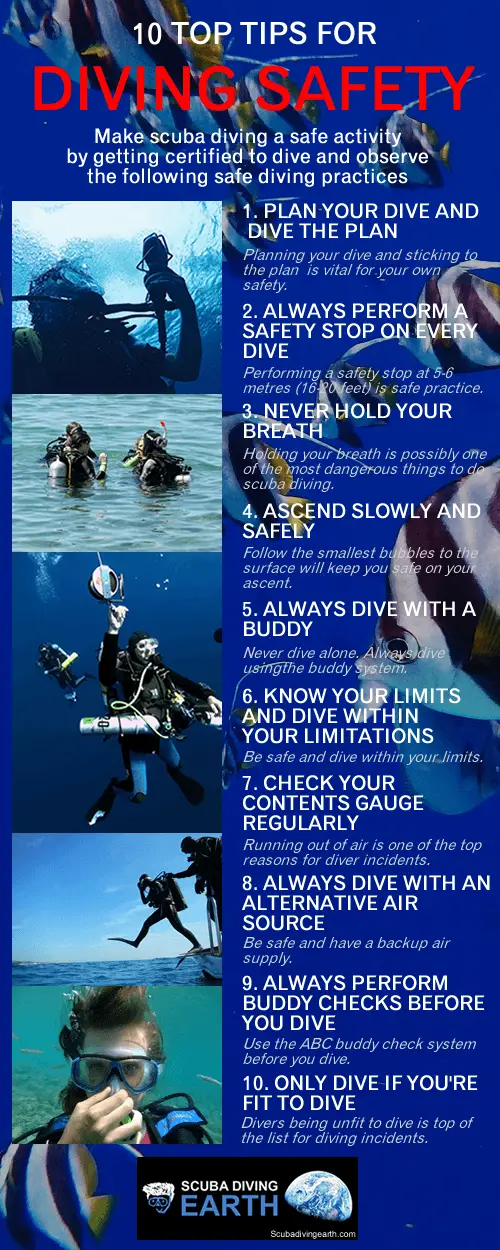
Make scuba diving safe by following these top 10 tips for diving safety – This includes the top 3 rules of scuba diving
Scuba diving is classed as a dangerous sport. which is all the more reason to follow good safety tips for scuba diving. You can minimise these risks by following our 10 top safety tips for scuba diving.
The top 10 safety tips for scuba diving include:
- Never hold your breath.
- Never without a buddy.
- Ascend slowly from every dive.
- Perform a safety stop at 5-6 metres (16-20 feet).
- Plan your dive and dive the plan.
- Know your limits and dive within your limitations.
- Check your air contents gauge regularly.
- Always dive with an alternative air source or octopus.
- Always perform the ABC buddy check before your dive.
- Only dive if you’re fit to dive.
The best way to do more diving is to book yourself on a scuba diving liveaboard. You can check the latest and best deals on liveaboards using the following window:
Please don’t leave before you watch the video in this article! After you’ve got your answer about safety tips for scuba diving, you may like to watch the video on this article too. I almost don’t want to spoil the end of the video, so all I will say is it involves a carcass, many sharks and a single grouper…you may be surprised at what happens, I certainly was!
But also as an aside, in this article about where to find great white sharks, you may be as surprised as I was to discover some of the places where you find great white sharks! Place number 6 is the one that surprised me the most, but if you live in the States, you may be more surprised at places two, three and four.
Is scuba diving dangerous?
Ironically, as I’m writing this article the presenter on BBC Radio 2 is talking about parachute jumping. Why is this important you might ask when you’re reading an article about safety tips for scuba diving?
A good question. Well a short while back I wrote an article about is scuba diving more dangerous than skydiving. It actually turns out that scuba diving is more dangerous than skydiving. In fact the odds of dying whilst scuba diving are nearly three times that of skydiving.
Don’t let this worry you if you’re new to scuba diving. I’m not looking to put you off diving, but instead this article is to highlight the dangers and to keep you safe by giving you the safety rules to follow.
That’s why I’ve chosen to write another article about safe diving practices. A while back I wrote a comprehensive article with 26 rules for safe scuba diving.
What I’ve done in this article is to focus on the most important 10 safety tips for scuba diving, beginning with the main 3 rules of scuba diving.
Plus I’ve created the above top ten safety tips image shown above, which you could download and laminate for a reminder. This is especially true for beginner scuba divers.
Have you heard about the ‘Scuba Diving Lizard‘? Take a read of this article about a lizard that can breathe underwater from a scuba-tank like bubble…I was fascinated when I read this!

Top three safety tips for scuba diving
Safety tips for scuba diving begins with the top 3 rules of scuba diving. These include:
- Never hold your breath: Breathe continuously while scuba diving.
- Never dive without a buddy: Always dive using the buddy system and never dive alone.
- Ascend slowly use safety stops: Always perform a safety stop at 5-6 metres (16-20 feet) at the end of all dives.
The 3 rules of scuba diving explained in more detail.
3 rules of scuba diving
Follow these top 3 rules of scuba diving and you’ll be safe:
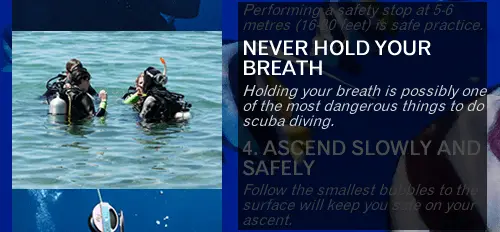
1. Top safety tip is to never hold your breath and breathe continuously while scuba diving
One of the most important safety tips for scuba diving is to never hold your breath. Holding your breath can cause serious damage to your lungs as a result of lung over-expansion.
Please take a read of this article about Boyle’s law scuba diving. This article explains what happens to your air spaces when you dive. Which in this case is the air inside your lungs, which contract during descent and expand during ascent.
This is the number one rule I would drum into my students when I taught scuba diving, which was to breathe continuously.
Holding your breath when you change depth can result in an over-expansion of your lungs. This can happen even with the smallest of depth change. Especially at shallower depths when the changes in pressure are greater as you ascend.
An over-expansion of your lungs can result in extremely serious consequences. Even death. The symptoms include pain, shortness of breath, difficulty in breathing, and can lead to unconsciousness.
If this happens to a diver in your group give them oxygen and call the emergency services immediately.
Pro diver tip: You will be safe so long as you breath continuously, especially on your ascent at the end of a dive.
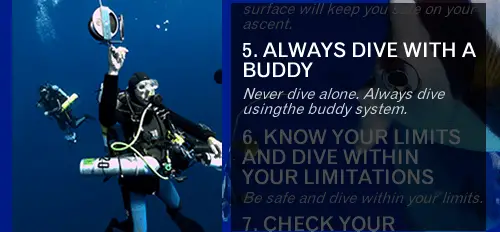
2. Top safety tip for scuba diving is never dive without a buddy and never dive alone
One of the top safety tips for scuba diving is never dive without a buddy. The diving buddy system is there to protect both divers in case or equipment failure or an emergency. Always, remember you are in a foreign environment in which you cannot breathe without a working aqualung. If this fails you have your buddy as a back up
As a diving instructor I taught the buddy system. BSAC training is built around teaching beginner scuba divers in buddy pairs. The buddy system is ingrained at an early stage with BSAC training. The same is true of the PADI diver training. PADI divers are also taught the buddy system too.
An example always helps to explain any point. Which in this case involved my buddy’s first stage exploding underwater.
In case you’re wondering what happens when a first stage bursts underwater; it’s one huge mass of bubbles. In fact, I couldn’t see my buddy through the mass of white bubbles that engulfed him when it happened.
More Reading: How do I get a dive buddy? (5 easy ways to find a dive buddy)
My instinct was to rush to his rescue. I offered him my alternative air supply or octopus. I then turned his own air supply off to stop the bubbles. We then ascended safely to the surface together.
Had he been diving alone the outcome may have been different.
Whether he could have got to the surface before his air ran out is questionable. He may have done if he’d rushed to the surface. But as you will learn or already know, scuba divers must ascend slowly to avoid decompression sickness.
Statistics from DAN, BSAC and DAN Australia show that in 86 percent of scuba diving fatalities the diver was alone when they died.
Pro diver tip: Always dive in buddy pairs so that if anything goes wrong either your equipment or with your buddy’s diving equipment you are more likely to return to the surface safely.
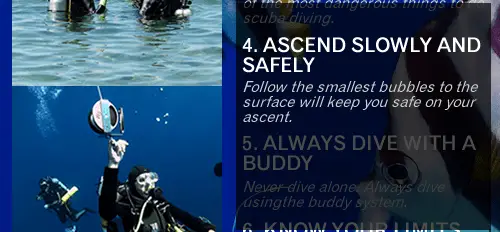
3. Safe diving involves ascending slowly from every dive
Safe scuba diving means you should use your dive computer to control your ascent to a slow ascent rate on every dive, no matter how deep the dive. Every dive is a decompression dive, which means your body needs to time to decompress slowly from whatever depth you’ve dived to.
Dive computers have a built-in ascent rate monitor to keep your ascent-rate within safe parameters until you reach the surface. A slow ascent will prevent decompression sickness and prevent you from over expanding your lungs.
Combined research into diving fatalities from the Diver’s Alert Network (DAN) in the U.S. and Australia and BSAC in the U.K. showed that an uncontrolled ascent was the triggering factor in 26 percent of the diver fatalities analysed.
If you don’t have a dive computer (or if it fails) follow the following guidelines:
- Use your buddy’s dive computer for a safe ascent if they have one.
- Follow a safe ascent alongside the dive master if you are diving in a group.
- Follow behind your smallest regulator exhaust bubbles to the surface. These are the bubbles that are the size of champagne bubbles.
Pro diver tip: Always leave the bottom with plenty of reserve air. This should be enough air to allow for your slow ascent.
Further 7 rules or safety tips for scuba diving
In addition to the above three safety tips for scuba diving, the following seven rules are also important and should be followed each time you scuba dive.
4. Safe scuba diving includes doing safety stops at 5-6 metres (16-20 feet)
In addition to a slow ascent you should always do a safety stop at 5-6 metres (16-20 feet) at the end of every dive. By doing a safety stop you allow extra time for excess nitrogen to escape your body.
Your safety stop forces you to slow your ascent even more and further reduces the risk of getting the bends or decompression sickness (DCS).
5. Safe diving is about planning the dive and dive the plan
Safe diving include planning your dives. Your dive may be planned for you, especially if you’re on an organised dive trip. But whichever is the case you should always follow the plan. Always attend and pay attention to the diver briefing if you haven’t planned the dive.
The most basic rules of planning the dive and dive the plan includes an agreement about a maximum depth and dive-time before the dive. Knowing this before the dive is as much for you as it is for the skipper on the boat.
It’s when you start to deviate from the plan that things can go wrong and you may put you and your buddy at risk.
Agree on your emergency lost-diver procedures. This includes what to do in the situation if you become separated from your buddy. Always surface immediately after a quick search for your buddy. Never continue with your dive if you are separated from your dive buddy.
More Reading: What should you and your buddy do if separated during a dive?
Also agree on hand signals before you dive. An important example of where confusion could arise with diver hand signals is the signal used for a half-full tank of air. For example, in Asia and the Caribbean they use the same signal for half-full tank of air as divers in Africa use to signal the end of the dive.
6. Knowing your limits and dive within your limitations means you will be scuba diving safely
Depth limits are set for a reason and it’s important to follow the rules and dive within your limits for your own safety and the safety of your buddy.
I always advise divers to take things slowly. This is particularly important for beginner scuba divers coming up through the ranks.
Take your time to build your experience. Don’t rush to dive deep or to to drift dive without having built up your experience with the more straight forward shallow dives.
Build your experience (at least 20 dives) before you take further certifications to enable you to dive deeper and to take part in more adventurous situations.
Never be afraid to refuse a dive. Never be uncomfortable when you go down on a dive, as this may put you and your buddy in danger.
If you aren’t physically or mentally capable of your planned dive, don’t do it. We can all be put under pressure to do something we don’t want to do. But in the case of scuba diving, this may put you at risk, so don’t succumb to peer pressure.
7. Safety tips for scuba diving includes checking your air contents gauge regularly
My rule of thumb for how you should check your air contents gauge is as follows:
- 10 metres (33 feet): Check your air every 15-20 minutes.
- 15-20 metres (49-66 feet): Check your air every 10-12 minutes.
- 24-30 metres (80-98 feet): Check your air every 5-8 minutes.
- 33 to 40 metres (110-130 feet): Check your air every 3-4 minutes.
Please note the about time limits are a minimum, but my assessment is based on checking at least four times per dive.
You may also like to read my article about how deep you can dive without decompression. But in particular, the section on no-stop decompression limits. When you read this article and see that your no-stop decompression limit at 30 metres is just 20 minutes, checking your air every 5 minutes is only four times on the dive.
Your air runs out much faster at deeper depths, which means if you have a problem (for example an air leak), your air supply could run out very quickly. Which is why I recommend shorter intervals for your air checks, the deeper you dive.
According to the diver fatality statistics provided by the Divers Alert Network (DAN), insufficient air supply was the leading cause of fatal emergency ascents for scuba diving deaths analysed.
Many, if not all of these incidents could easily have been avoided if the divers concerned had properly monitored their air contents gauges throughout their dive.
Pro diver Tip: Check your air contents gauge on a regular basis to make sure you never run out of air. Always return to the surface with sufficient reserve air which is a minimum of 50 BAR (725PSI) to ensure your safety. Apply the rule of thirds to air management. The rule of thirds means: You designate a third of your air for the outward journey; a third for the return journey; and the final third as a safety reserve.
8. Safe diving means you always dive with an alternative air source (octopus)
Safety tips for scuba diving includes always diving with an alternative air source as a backup air supply for your dive buddy. Diving equipment can fail underwater, which is why it’s important to have a backup air supply such as an octopus with an extra-length hose.
In the example I explained above when my buddy’s first stage blew, I was able to rescue him with my alternative air source. Had I not had tan alternative air source we would have had to share my main regulator to return to the surface safely.
A similar incident happened on a dive in Bonaire. This time my buddy was having problems with his second stage. In this case it was his first stage that wasn’t delivering air to his regulator.
Once again, I came to his rescue and gave him my octopus or alternative air supply so we could return to the surface safely.
9. Safe scuba diving means performing buddy checks before you dive
Use the ABC buddy checking system before you dive to familiarise yourself with your buddy’s equipment and them with yours. A buddy safety check also confirms your scuba equipment is in good working order before you dive.
If you find it difficult to remember the buddy check, I’ve written an article on the diving buddy check acronym. This acronym is as follows:
- A is for air – This checks your air is switch on. It checks that your equipment is working properly and the air is good.
- B is for buoyancy – This is to check that your buoyancy control device and air feeds are in working order. Plus it familiarises your buddy with where your air feeds and dump valves are.
- C is for clips and releases – By running through your clips and releases, your buddy will know where things are in an emergency should this occur.
10. Scuba diving safety includes diving only if you’re fit to dive
You should only dive if you fit to do so, which includes not going diving if you have a cold or you are congested in your ears or nose. If you are in any doubt about your fitness to scuba dive consult with your doctor first.
It’s better to be safe than sorry. Scuba diving can put your body under additional pressures and stress, which means diving could highlight any fitness problems you have.
According to DAN, cardiovascular events cause 20 to 30 percent of all deaths that occur while scuba diving.
Staying fit and healthy will not only keep you safe when you’re scuba diving, but it will also help you to enjoy the sport much more. The fitter you are the better you’ll be at air conservation, which means you’ll be able to dive for longer, as your air will last longer.
More Reading: What should you not do after scuba diving (11 must NOT do’s after diving)
Please don’t leave before you watch the video in this article! So before you, you may like to watch the video on this article too. I almost don’t want to spoil the end of the video, so all I will say is it involves a carcass, many sharks and a single grouper…you may be surprised at what happens, I certainly was!
Please also don’t forget to take a look at this article about where to find great white sharks, you may be as surprised as I was to discover some of the places where you find great white sharks! Place number 6 is the one that surprised me the most, but if you live in the States, you may be more surprised at places two, three and four.
I hope you enjoyed this article about safety tips for scuba diving
I’d love to hear from you. Tell us about your adventures of diving and snorkeling, in the comments below. Please also share your photos. Either from your underwater cameras or videos from your waterproof Gopro’s!
If this article hasn’t answered all of your questions. If you have more questions either about snorkeling or types of scuba diving (or specifically about safety tips for scuba diving), please comment below with your questions.
There will also be many more articles about scuba diving (and snorkeling) for you to read and learn about these fabulous sports.
Have fun and be safe!

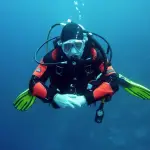
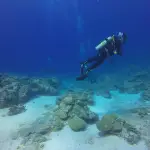
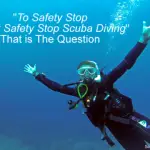


I like how you mentioned that when scuba diving, you should breathe continuously while scuba diving, and never hold your breath. My husband and I are going on a cruise this summer, and we are signed up to go scuba diving, but I’ve never done it before and I don’t know what to expect. I will definitely keep all of your great tips and information in mind when scuba diving on my cruise this summer.
Hello Brooklyn, thank you for your kind comment about my article. I hope you enjoy your trip and your first scuba diving experience. Please come back and tell me all about it.
It’s surprising that insufficient air supply is the leading cause of fatal accidents for scuba diving. I am planning on a diving trip with my friends and want to make sure that I am safe while I am underwater. When it is time for me to start diving I will make sure to check my air contents gauge frequently.
Hi Stefan, thank you for your comment. Yes it is surprising, but it goes to show how important the training is for scuba divers. Enjoy your next diving trip and please come back to tell us all about it.